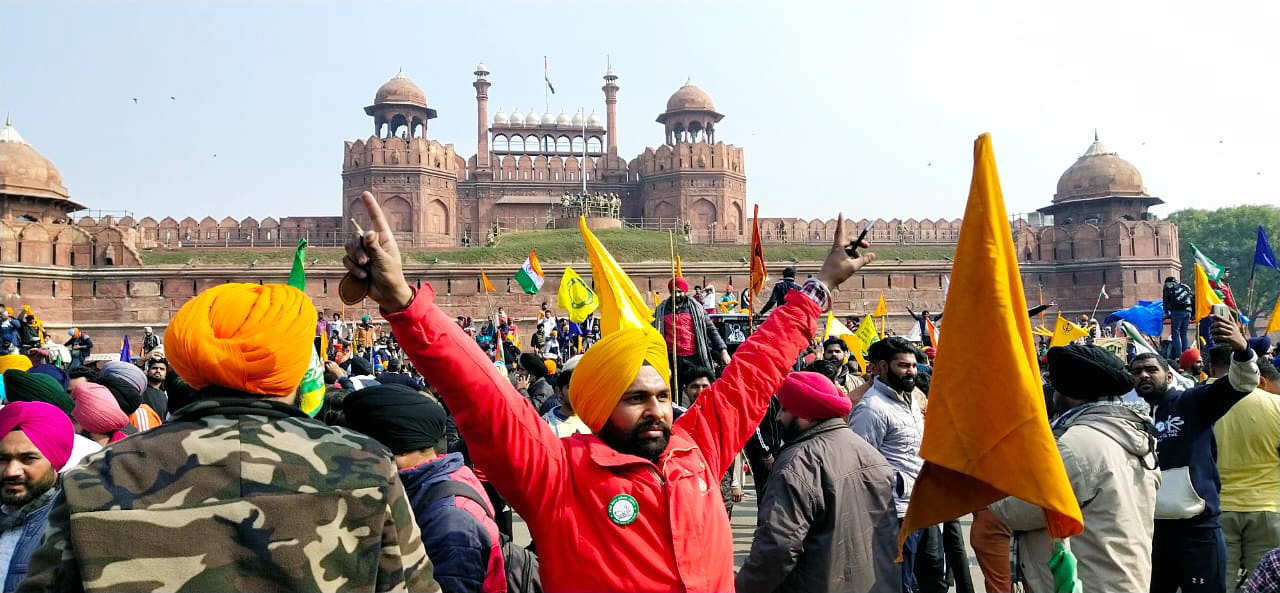Unlike Go Rakshak mayhem of 1966, State shows restraint; but was tractor rally permission prudent?
Irony was writ large. Three days after Prime Minister Narendra Modi had led the nation in paying tribute to the memory of Subhas Chandra Bose, the core stanza of the Indian National Army’s marching song, Kadam kadam barhaye jaa… “Chalo Dillī pukār ke ,qaumī-nishān sambhāl ke, Lāl qile pe gāṛh ke, lahrāye jā lahrāye jā (Let ‘Towards Delhi’ be your war-cry; And hold the nation’s [Tricolour] flag high; plant it on the Red Fort and wave it high, wave it high)” was put to utter ridicule. A marauding mob laid siege to the icon of India’s State power, Delhi’s Red Fort (which is referred to by its original Urdu nomenclature, “Quila-e-mualla” in Sikh history) and foisted the Sikh Panthic triangular yellow “Nishan sahib” on the flag mast used by the Prime Minister of India since 15 August 1947 to hoist the national Tricolour. In doing so the buccaneers tried to re-enact the “Qila Fateh” achieved by a Sikh army led by Baghel Singh Dhaliwal in 1783 (historians have not authenticated this, but legend has prevailed; the Delhi Sikh Gurdwara Management Committee annually observes “Fateh Diwas” to commemorate).
The events of 26 January 2021 brought back memory of 7 November 1966, when a mob of ash-smeared, trident bearing naked sadhus had caused mayhem on the Sansad Marg and tried to break into the Parliament House during an anti-cow slaughter “Go Raksha” agitation. They damaged government offices; ransacked the residences of politicians, including the home of the Congress president, K. Kamaraj. Renowned social anthropologist M.N. Srinivas reacted to this fracas by saying that the episode solidly convinced him that a section of the inhabitants of North India had not evolved into modern people. The sadhus in 1966 carried tridents with which they attacked policemen. The mob on Tuesday carried swords and “gandasas”. Policemen near Red Fort had to jump off 20-foot-high parapets to escape the assault of primitive weaponry. In 1966, police had opened fire. The apparent failure of intelligence and breakdown of effective law and order mechanism notwithstanding, Delhi Police warrant encomium for exercising restraint and not opening fire, which, under the circumstances, it may have been entitled to on Tuesday. Eight deaths of 7 November 1966 were sought to be projected against the nascent regime of Indira Gandhi (she had been in power barely just over nine months then) and she was accused of slaying “hundreds of sadhus”. Home Minister Gulzari Lal Nanda (the man who had twice been acting Prime Minister, after deaths of Jawaharlal Nehru and Lal Bhadur Shastri) was sacked. Fortunately, there were no casualties on 26 January 2021. (In the elections that followed in March 1967 Congress was wiped out in nine states for the first time—it was said you could traverse the Grand Trunk Road from Amritsar to Calcutta without being in the jurisdiction of a Congress state government.)
Democracy in the USA was abashed by the incidents on the Capitol in Washington, DC on 6 January. The Capitol Police in the USA has apologised to the Parliament (US Congress) that despite knowing that there was a “strong potential for violence” it had failed to take adequate steps to prevent the “terrorist attack”. Taking recourse to face-identification technology the American police has initiated action against the miscreants. Likewise, Delhi Police too has harnessed technology and swung into action post facto. 25,000 armed troops had been deployed at the Capitol on 20 January when President Joe Biden was sworn in—considering that USA has 2,500 troops each in Afghanistan and Iraq, the threat perception can be fathomed. Similarly adequate paramilitary personnel should have been kept on standby in New Delhi, commensurate with the looming peril, considering the belligerency displayed by the agitators during the prolonged standoff across the National Capital Territory borders over past weeks. The Supreme Court had left it to the discretion of Delhi Police whether tractor rally was to be allowed. Union Home Ministry ought to have exercised abundant caution before permitting a potentially volatile gathering in New Delhi on the Republic Day.
Protests were not confined to Delhi—rallies were held against the three laws at 20 other locations across the nation. There was no violence in those protests. Political parties were active in the demonstrations in other parts of the country. Total absence of political leadership in the Delhi turmoil gave a free hand to lumpens, criminals and anti-nationals.
The fire was lit by the decision of the Congress government in Punjab to initiate legislation in the Vidhan Sabha to negate laws passed by Parliament of India. Left Front regime in Kerala and Congress regimes in other states followed suit. If nation’s Parliament is sought to be ridiculed, the Republic may be in peril. During passage of these laws, Opposition in Parliament had demanded wider discussion, which was brushed aside. It is indeed remarkable that during the last session Parliament passed 27 bills despite shorter sessions and limited hours of work due to Covid. Parliament is a forum for discussion, debate and disposal of issues. Short circuiting the process has its intrinsic perils.
The three laws, which economists by and large say are positive for taking forward reform, were introduced as ordinances and later legislated through the Houses of Parliament. As things stand, government seems inclined to defer their implementation by 18 months or so—Ordinances are promulgated when there is an urgency. Bharat Ratna Pranab Mukherjee, in his last tome, “Presidential Years”, had cautioned against the use of the ordinance route and advocated thorough consultation and discussion. The events of 26 January 2021 cast a long shadow and call for introspection.

